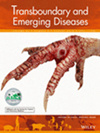

Journal Title:Transboundary And Emerging Diseases
Transboundary and Emerging Diseases brings together in one place the latest research on infectious diseases considered to hold the greatest economic threat to animals and humans worldwide. The journal provides a venue for global research on their diagnosis, prevention and management, and for papers on public health, pathogenesis, epidemiology, statistical modeling, diagnostics, biosecurity issues, genomics, vaccine development and rapid communication of new outbreaks. Papers should include timely research approaches using state-of-the-art technologies. The editors encourage papers adopting a science-based approach on socio-economic and environmental factors influencing the management of the bio-security threat posed by these diseases, including risk analysis and disease spread modeling. Preference will be given to communications focusing on novel science-based approaches to controlling transboundary and emerging diseases. The following topics are generally considered out-of-scope, but decisions are made on a case-by-case basis (for example, studies on cryptic wildlife populations, and those on potential species extinctions):
Pathogen discovery: a common pathogen newly recognised in a specific country, or a new pathogen or genetic sequence for which there is little context about — or insights regarding — its emergence or spread.
Prevalence estimation surveys and risk factor studies based on survey (rather than longitudinal) methodology, except when such studies are unique. Surveys of knowledge, attitudes and practices are within scope.
Diagnostic test development if not accompanied by robust sensitivity and specificity estimation from field studies.
Studies focused only on laboratory methods in which relevance to disease emergence and spread is not obvious or can not be inferred (“pure research” type studies).
Narrative literature reviews which do not generate new knowledge. Systematic and scoping reviews, and meta-analyses are within scope.
Transboundary and Emerging Diseases 汇集了有关传染病的最新研究,这些研究被认为对全球动物和人类构成最大的经济威胁。该杂志为全球研究其诊断、预防和管理,以及关于公共卫生、发病机制、流行病学、统计建模、诊断、生物安全问题、基因组学、疫苗开发和新爆发的快速沟通的论文提供了场所。论文应包括使用最先进技术的及时研究方法。编辑鼓励论文采用基于科学的方法来研究影响这些疾病带来的生物安全威胁管理的社会经济和环境因素,包括风险分析和疾病传播建模。将优先关注以科学为基础的新方法来控制跨界疾病和新发疾病的交流。以下主题通常被认为超出范围,但会根据具体情况做出决定(例如,对神秘的野生动物种群的研究,以及关于潜在物种灭绝的研究):
病原体发现:在特定国家新发现的常见病原体,或新病原体或基因序列,对其出现或传播几乎没有背景或见解。
基于调查(而非纵向)方法的流行率估计调查和风险因素研究,除非此类研究是独一无二的。知识、态度和实践的调查都在范围内。
如果没有来自现场研究的可靠的敏感性和特异性估计,诊断测试的开发。
研究仅侧重于与疾病出现和传播的相关性不明显或无法推断的实验室方法(“纯研究”型研究)。
不会产生新知识的叙述性文献评论。系统和范围审查以及荟萃分析都在范围内。
| 大类学科 | 小类学科 | 分区 | Top期刊 | 综述期刊 |
| 农林科学 | VETERINARY SCIENCES 兽医学 INFECTIOUS DISEASES 传染病学 | 2区 | 是 | 是 |
| 大类学科 | 小类学科 | 分区 |
| 农林科学 | VETERINARY SCIENCES 兽医学 INFECTIOUS DISEASES 传染病学 | 2区 |
| 期刊名称 | 领域 | 中科院分区 | 影响因子 |
| Arthropod-plant Interactions | 农林科学 | 2区 | 1.600 |
| Entomologia Experimentalis Et Applicata | 农林科学 | 2区 | 1.900 |
| Medical And Veterinary Entomology | 农林科学 | 2区 | 1.900 |
| Croatian Journal Of Forest Engineering | 农林科学 | 2区 | 3.200 |
| Croatian Journal Of Forest Engineering | 农林科学 | 2区 | 3.200 |
| Experimental And Applied Acarology | 农林科学 | 2区 | 2.200 |